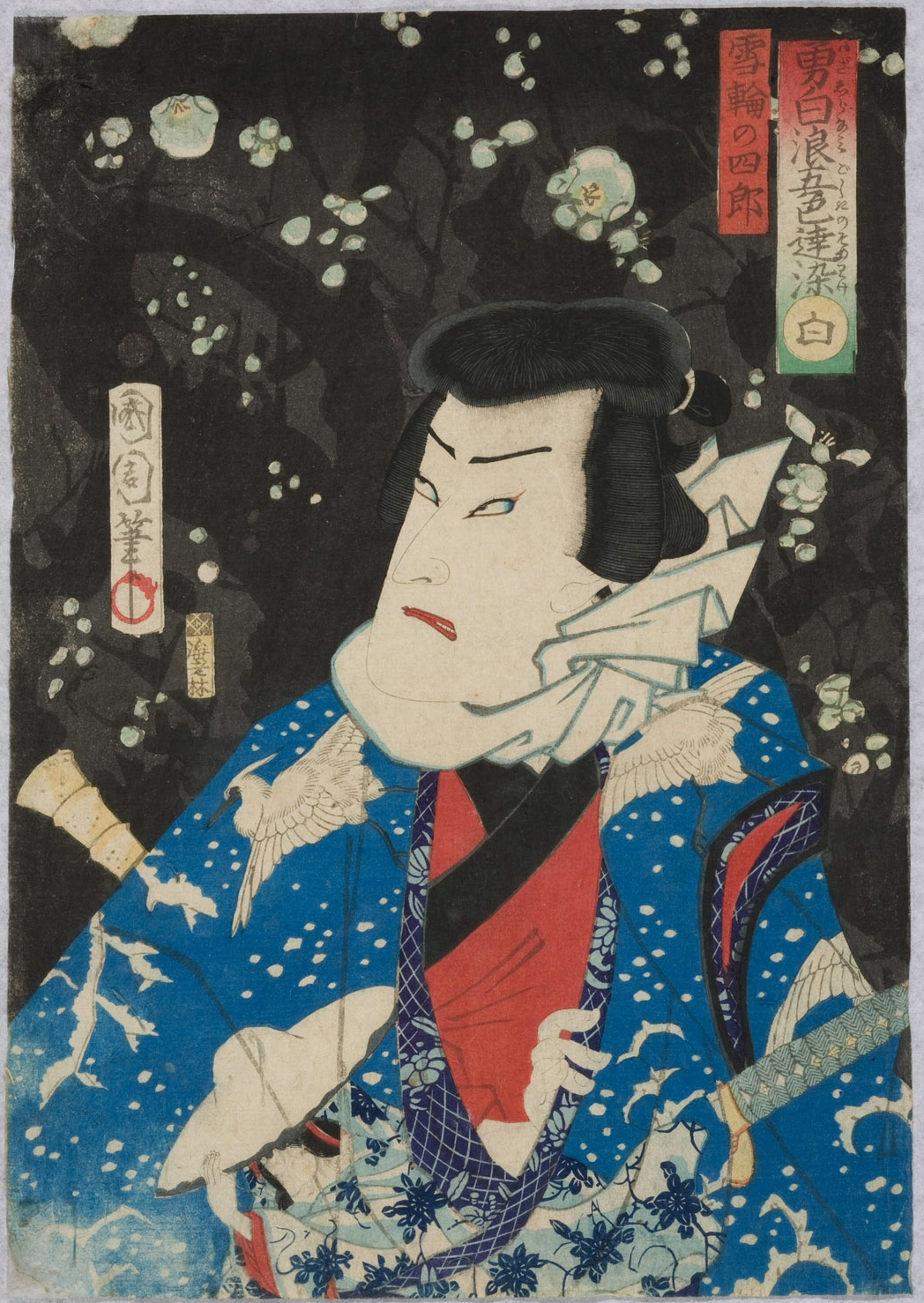Activity
Create a Simulated Woodblock Print
Objective: Students will be able to identify, compare and contrast images of traditional Japanese woodblock prints. They will then create their own simulated woodblock prints.

A Kabuki actor as the bandit Shiro in falling snow, from the play Five Courageous Bandits in Five Colors, white, 1850-1900.
Content Standards (California)
VPA/VA 4.4.4: Identify and describe how various cultures define and value art differently. VPA/VA 5.1.1: Identify and describe the principles of design in visual compositions, emphasizing unity and harmony. VPA/VA 5.4.1: Identify how selected principles of design are used in a work of art and how they affect personal responses to and evaluation of the work of art. VPA/VA 6.1.1: Identify and describe all the elements of art found in selected works of art (e.g., color, shape/form, line, texture, space, value). VPA/VA 6.1.4: Describe how balance is effectively used in a work of art (e.g., symmetrical, asymmetrical, radial). VPA/VA: 9-12.1.4: Analyze and describe how the composition of a work of art is affected by the use of a particular principle of design.
Materials
Video: Hokusai and Hiroshige; Other: styrofoam, piece of linoleum or SCRATCH-FORM (made by SCRATCH-ART) board; watercolors (in trays or tube sets); liquid dishwashing soap, preferably clear-colored; small plate for a palette; small paint brush; pencil or ballpoint pen; fineline black pen; white drawing paper (70 or 80 lb. if possible); masking tape
Procedure
- View the video Hokusai and Hiroshige with your students for an overview of Japanese woodblock prints.
- Select two examples of woodblock prints illustrating different themes (i.e., landscapes, bridges, waterfalls, mountains, travel, or life in Edo) from the Asian Art Museum’s Online Collection. Ask students to compare and contrast the two prints. Possible questions are:
- Describe the composition of both prints. What major elements are there in each? Is there a play of shapes or empty and filled spaces? Would you describe the compositions as asymmeterical or symmetrical? Balanced or unbalanced?
- Do you see changes in color or variations? What painting techniques might have been used to achieve such effects?
- How are the prints different or similar in terms of line quality? Do the lines have different thickness and movements?
- Are there people in the prints? If so, how does the artist portray them?
- What is the overall mood of the prints? What do you think the artist is trying to communicate?
- Have students sketch an image on their board inspired by the woodblock prints they have just viewed. Encourage them to create designs comprised of flat shapes to completely fill the space available. The outlines of their designs can be traced directly onto their boards or carved into the board. After the images are transferred, have students retrace their outlines with a ballpoint pen or blunt pencil to create “valleys” between the shapes.
- Cut a piece of drawing paper at least one inch larger on all sides than the board. (For example, a 4×5 inch board would need a 6×7 inch piece of paper.)
- Fold the paper around one side of the board and secure on the back with masking tape. This hinge will serve as a registration for the printing process that involves lifting and printing the paper many times. Students must lay the paper over the board in exactly the same place for each color pass to achieve a clear final image.
- Students can then start coloring and printing their designs. For each separate color, have them mix the paint with a small amount of liquid soap on their palettes, place the hinged paper over the board, pressing firmly so that the paint transfers to the paper.
- Ask certain students to keep paint on the flat shapes and not in the valleys between the shapes. Continue to paint and press until all the colors have been transferred one at a time.
- Once the printed areas are dry, students can add texture or gradations of color on top of previously printed areas for depth.
- Using a fine black pen, have students outline figures in their design. This will simulate the black outlines found in woodblock prints. Seals can be added and written in to give the print the look of a signed woodblock print.
- Have students remove the paper from their board and smooth out the fold. The print will have a one inch border and all four sides and can be framed.
Extension Activity
Ask students to write a poem (such as a haiku) or choose a quote to accompany their print to express a mood or image.
This activity was developed by Sherie Yazman, George Washington High School, San Francisco Unified School District (1998).




